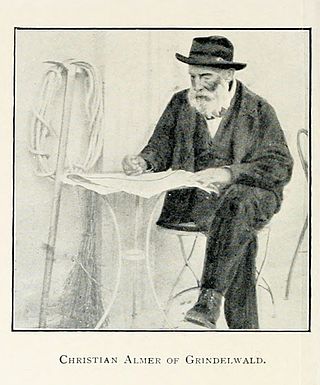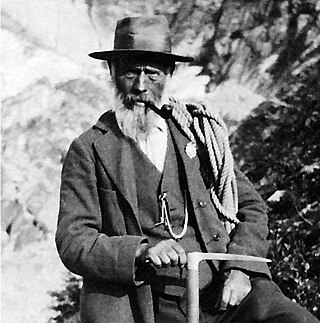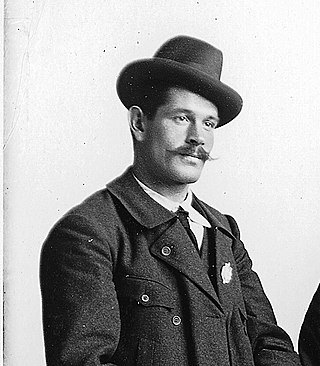
The Jungfrau Railway is a mountain rack railway in the Bernese Alps, Switzerland, connecting Kleine Scheidegg in the Bernese Oberland to the Jungfraujoch, across the Valais border. It is the highest railway in Switzerland and Europe, running 9 kilometres (5.6 mi) from the station of Kleine Scheidegg to the Jungfraujoch, well above the perennial snow line. As a consequence, the railway runs essentially within the Jungfrau Tunnel, built into the neighbouring Eiger and Mönch, to protect the line from snow and extreme weather.

The Jungfrau, at 4,158 meters (13,642 ft) is one of the main summits of the Bernese Alps, located between the northern canton of Bern and the southern canton of Valais, halfway between Interlaken and Fiesch. Together with the Eiger and Mönch, the Jungfrau forms a massive wall of mountains overlooking the Bernese Oberland and the Swiss Plateau, one of the most distinctive sights of the Swiss Alps.

The Eiger is a 3,967-metre (13,015 ft) mountain of the Bernese Alps, overlooking Grindelwald and Lauterbrunnen in the Bernese Oberland of Switzerland, just north of the main watershed and border with Valais. It is the easternmost peak of a ridge crest that extends across the Mönch to the Jungfrau at 4,158 m (13,642 ft), constituting one of the most emblematic sights of the Swiss Alps. While the northern side of the mountain rises more than 3,000 m (10,000 ft) above the two valleys of Grindelwald and Lauterbrunnen, the southern side faces the large glaciers of the Jungfrau-Aletsch area, the most glaciated region in the Alps. The most notable feature of the Eiger is its nearly 1,800-metre-high (5,900 ft) north face of rock and ice, named Eiger-Nordwand, Eigerwand or just Nordwand, which is the biggest north face in the Alps. This huge face towers over the resort of Kleine Scheidegg at its base, on the eponymous pass connecting the two valleys.

Grindelwald is a village and municipality in the Interlaken-Oberhasli administrative district in the canton of Berne. In addition to the village of Grindelwald, the municipality also includes the settlements of Alpiglen, Burglauenen, Grund, Itramen, Mühlebach, Schwendi, Tschingelberg and Wargistal.

The Kleine Scheidegg is a mountain pass at an elevation of 2,061 m (6,762 ft), situated below and between the Eiger and Lauberhorn peaks in the Bernese Oberland region of Switzerland. The name means "minor watershed", as it only divides the two arms of the Lütschine river, both converging at Zweilütschinen, while the nearby Grosse Scheidegg divides the Lütschine from the Rychenbach stream.

The Jungfraujoch is a saddle connecting two major 4000ers of the Bernese Alps: the Jungfrau and the Mönch. It lies at an elevation of 3,463 metres (11,362 ft) above sea level and is directly overlooked by the rocky prominence of the Sphinx. The Jungfraujoch is a glacier saddle, on the upper snows of the Aletsch Glacier, and part of the Jungfrau-Aletsch area, situated on the boundary between the cantons of Bern and Valais, halfway between Interlaken and Fiesch.

The Wengernalp is an alpine meadow at an elevation of 1874 m, above Wengen in the Bernese Oberland of Switzerland.
Fritz Kaufmann was a Swiss ski jumper and Nordic combined skier who competed in the 1930s. He was born in Grindelwald.

Christian Almer was a Swiss mountain guide and the first ascentionist of many prominent mountains in the western Alps during the golden and silver ages of alpinism. Almer was born and died in Grindelwald, Canton of Bern.

Kleine Scheidegg is a railway station and hub that is situated on the summit of Kleine Scheidegg, a mountain pass in the Bernese Oberland region of Switzerland. The pass, located between the Lauberhorn and the Eiger's ridge, houses a complex of hotels and railway buildings. Administratively, the station is in the municipality of Lauterbrunnen in the canton of Bern, a few metres from the border with the municipality of Grindelwald.

Eigergletscher is a railway station in the municipality of Lauterbrunnen in the canton of Bern. The station is served by trains of the Jungfrau railway, which run to the Jungfraujoch from Kleine Scheidegg, where they connect with services from Interlaken, Lauterbrunnen, Wengen and Grindelwald via the Bernese Oberland railway and the Wengernalp railway.

Eigerwand is a currently disused underground railway station on the Jungfrau railway, which runs to the Jungfraujoch from Kleine Scheidegg. The station is situated just behind the north wall of the Eiger, and its principal purpose was to allow passengers to observe the view through a series of windows carved into the rock face. Trains to Jungfraujoch used to stop at the station for five minutes.

Jungfraujoch is an underground railway station situated near the Jungfraujoch, in the canton of Valais, a few metres from the border with the canton of Bern. At 3,454 metres (11,332 ft) above sea level, it is the terminus of the Jungfrau Railway and the highest railway station in Switzerland and Europe. The Jungfrau Railway runs from Kleine Scheidegg in the Bernese Oberland, through the Jungfrau Tunnel and crosses the border between the two cantons shortly before the terminus.

Maki Yūkō, also known as Maki Aritsune, was a Japanese mountain climber.

Samuel Brawand was a Swiss politician (SP) and mountaineer.

Peter Kaufmann was a Swiss mountain guide during the Silver Age of Alpinism (1865-1882) and the early twentieth century, who guided amateurs, experienced climbers, and several notables across glaciers, over mountain passes, and to the summits in the Swiss Alps, the Canadian Rockies, and the Selkirks.

Christian Kaufmann was a Swiss mountain guide who climbed in the Alps, the Canadian Rockies, the Selkirks, the Himalayas, and Norway, accomplishing several dozen first-ascents.

Peter Kaufmann-Bohren was a Swiss ski instructor and mountain guide, climbing in the Swiss Alps and the Canadian Rockies.

Hans Kaufmann was a Swiss mountain guide who served clients in the Alps, the Rocky Mountains, the Dolomites, the Carpathians, and the Andes.

Ulrich Almer was a Swiss mountain guide, born on 8 May 1849 in Grindelwald where he died on 4 September 1940. He made many premieres in the Alps, at the beginning with his father Christian Almer, one of the great guides of the golden age of mountaineering, and was one of the first Swiss guides to visit the Caucasus.



















